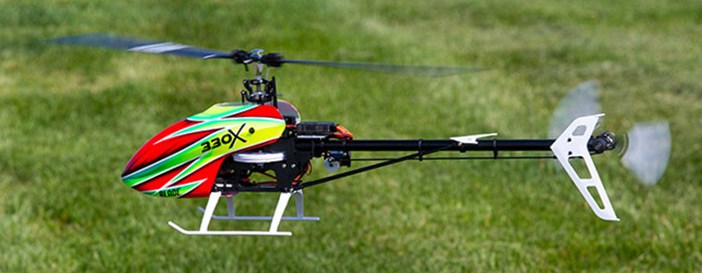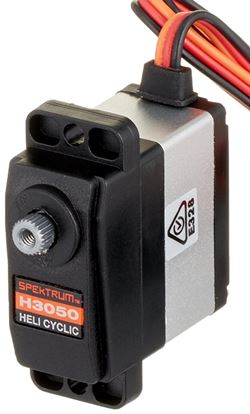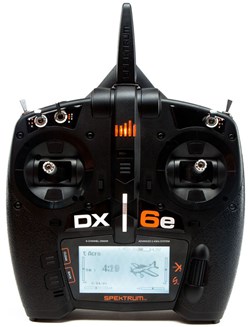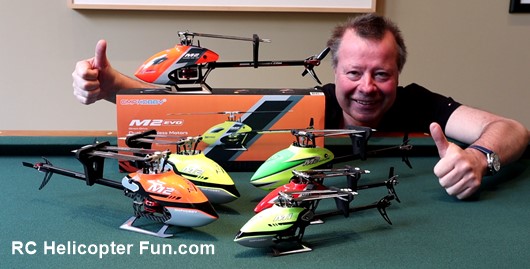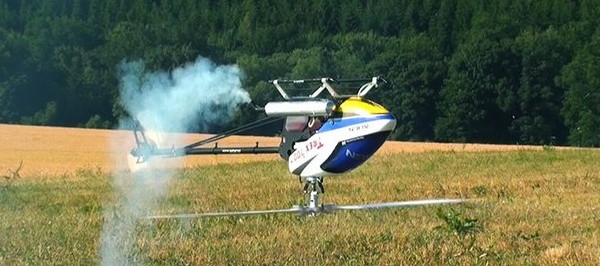Blade 330X
Back To The Basics!
by John Salt - Updated September 2021
To say I was somewhat happy to hear about the Blade 330X (replaced with the Blade 330S), would be considered an understatement.
Finally, a cost effective, not overly powerful 3S powered, 450 size, ready to fly RC helicopter. Perfect for those getting into collective pitch who don't want to waste time or money on micros. It's about time!
As I state on my Best RC Helicopter Page, there was for a short period of time, a big hole in the entry level RTF market for this type of helicopter. With this new Blade 330X and the new Align T-Rex 450LP (links to my page on it), we now have two great options once again!
As both these reviews and best RC helicopter page indicate, I still maintain that for many individuals, 450 size helis make the ideal first collective pitch helicopter when not over powered and correctly setup as a trainer.
They still have more than enough performance & power to get into aerobatics as your collective pitch piloting skills grow. Or even to get into scale RC helicopters with the many 450 size fuselages currently on the market if scale flying is your long term goal & passion.
The Blade 330X, just like the T-Rex 450LP, both excel at this wide spanning growth potential & varied flying styles while keeping costs at bay for the collective pitch newbie.
450 size RC helicopters are large enough to see at distance and have decent flight times, yet are not too intimidating. They can handle wind better than micro's and the components generally last longer, plus they are easier to work on. They also generally give you the most rotor size to dollar ratio of all heli sizes.
I get comments from way more people stating that "after flying a larger heli, they will never fly a micro again", than I do stating after flying a micro, they will never fly a large heli again.
In fact, I have never once got that comment.
To see Blade has gone back to the basics with a great "nuts & bolts" 450 size, easy & economical to live with 3S powered helicopter, should give all beginners new the hobby reason to smile.
It
should also give all current Blade 450 3D & 450X owners reason to
smile as well since almost all parts are shared so ongoing parts
availability & support will be no problem.
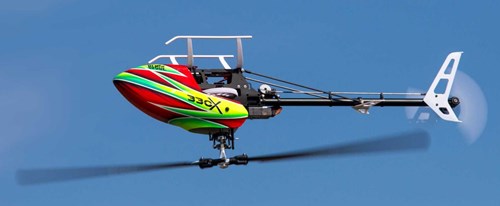 Right Side Up Or Inverted, The Blade 330X Looks Fantastic In The Air!
Right Side Up Or Inverted, The Blade 330X Looks Fantastic In The Air!Blade 330X Design Features & Components
I guess the first item to address here is the size. I keep calling the 330X a 450 size helicopter, but what do these numbers mean? I go over all RC helicopter sizes on my heli size page, but the usual way 450 helis were sized was to go by an arbitrary motor class size, in this case 400/450 class motors.
Recently, and thankfully, some manufacturers are starting to get away from motor class sizing and go by blade length sizing (like on larger size RC helis 550 and up), by using main rotor blade length. 400 & 450 size helicopters use main rotor blades that are 315mm to 330mm in length, and thus the 330 size nomenclature. The Blade 330X comes with 325mm long carbon fiber main rotor blades, but they round the heli size up to 330.
I still call this size of heli a 400/450, but I should get used to going by blade size as it will no doubt become the preferred method of sizing from micro size up to 800's and larger I predict.
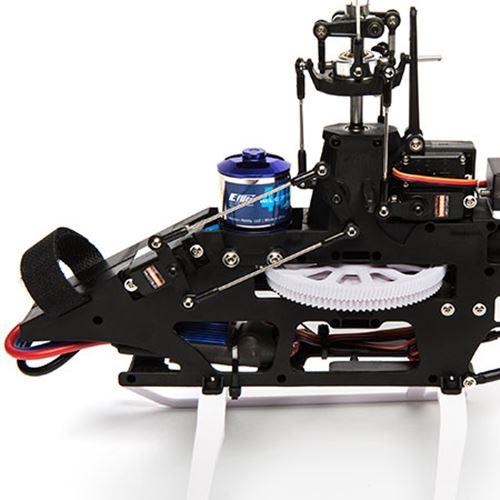 Blade 330X Mechanics Same As The Previous 450X
Blade 330X Mechanics Same As The Previous 450XAs seen above, the Blade 330X mechanics are identical to the 450X's. From the lightweight & durable two piece plastic frame, to the elevator bell crank servo layout, and power train including main and auto gears, along with belt driven tail drive components front & rear.
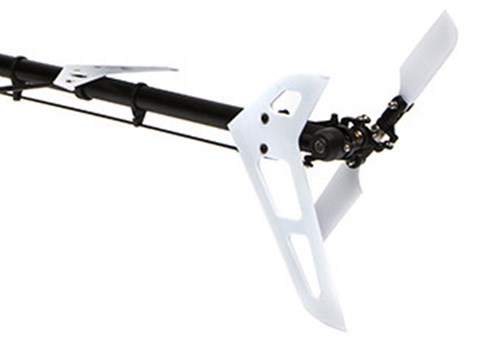 Blade 330X Belt Driven, Variable Pitch Tail Assembly
Blade 330X Belt Driven, Variable Pitch Tail AssemblyIn fact, when looking at the parts list of the Blade 330X, almost all parts are shared with the 450X, many with the 450 3D, and even a few with the iconic original Blade 400.
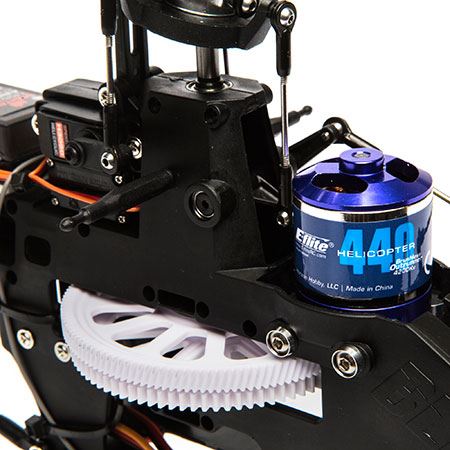 Blade 330X Uses E-flite's 440H 4200Kv Motor
Blade 330X Uses E-flite's 440H 4200Kv MotorEven the E-flite 440H 4200Kv motor used in the 450X, is now utilized in the 330X.
This motor is adequate, but the bearing failure rate has been quite high when flown hard.
It has been my own experience with this motor that premature bearing failures are caused primarily from lack of lubrication maintenance.
If you take the time to oil the two motor bearings every dozen or flight or so, this goes a long way to extend their life.
Yes, it's a pain, but considering most high end Scorpion motors call for even more frequent bearing lube intervals, it's not unheard of or even unexpected.
Considering a 450 size motor can spin upwards of a quarter million times each flight, it's amazing the lubrication can last as long as it does without breaking down.
It would be nice if a more robust motor/bearing/s were used, but that would drive costs up, and this helicopter is targeted to beginners who want to learn on a cost effective, ready to fly 450 size machine; not for accomplished aerobatic pilots that will be running at full power all the time.
The motor can always be upgraded inexpensively when you are ready for it or the bearings can be replaced with higher quality ones from Boca Bearing for example. A rather delicate and tedious task to perform on small brushless out-runner motors, but it's certainly a very cost effective option. Still, when first starting out, I have found the 440H motor will serve most folks quite well for a good many flights.
Of course the big cost saver with this motor is not the motor itself, it's that this 450 size heli (like most 450's size heli's of yesteryear) runs (and runs well I should add) on very common and economical 3S 2200 mAh LiPo battery packs, over high voltage 450's running on 6S packs in combination with 1800-2000Kv rated motors.
In short, 3S LiPo costs are about half of 6S, not to mention, 3S 2200
mAh packs are such a popular size. Chances are if you already fly RC
planes or quad-rotors, you likely already have LiPo's of this voltage
and capacity saving you even more money. I would recommend nothing less
than 30C discharge rated packs on any 3S powered 450. Go up to 35C or
higher when you start doing higher power demand aerobatic or 3D flying.
The Blade 330X uses 3 quality sub-micro digital metal geared Spektrum H3050 servos for cyclic, and a sub-micro digital metal geared Spektrum H3060 high speed tail servo for the tail rotor.
I have servo speed & torque specs at the bottom of the page under the specifications heading.
Nice to see higher quality metal geared servos being used on the 330X just like on the previous 450X V2 version.
Servo failures (stripped out plastic gear sets) were the number one complaint on the original Blade 400 and going with a metal geared servo certainly helps with this issue.
That said, metal geared servos strip out too as I talk about in more detail and why it happens on my servo page. The one nice design feature all of Blade's 400 & 450's and also on the 330X that further help with less servo gear stripping is the elevator bell crank layout. The elevator servo tends to be the most likely one to strip, and by going with a bell crank design over a direct servo pushrod linkage, you get some additional "mechanical fuse" protection within the linkages.

No worries however if/when you do strip out a gear set.
Spektrum is a well established brand and offers replacement gear sets for both the H3050 and H3060.
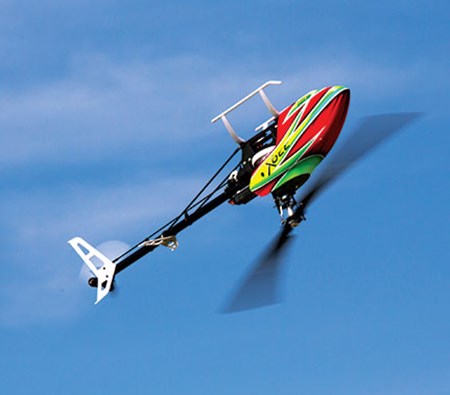 330X's Spektrum Digital MG Servos Up To The Task
330X's Spektrum Digital MG Servos Up To The TaskWith the 450X design & component similarities out of the way, now lets look at the few Blade 330X differences.
 Blade 330X 45 Amp ESC
Blade 330X 45 Amp ESCFirst up is a brand new Blade brand higher current 45 Amp ESC over the previous 35 Amp one (part # BLH5052).
To be honest, I have never had any issues running a 3S powered 450 size heli on a 35 Amp ESC.
I'm a sport & scale pilot and rarely (if ever) pull maximum power for sustained periods of time. When you are first learning to fly CP on a 450, 35 Amps are certainly enough, but it's nice to know if & when you do progress into aerobatics and light 3D, this new Blade ESC & built in switching BEC will have the power to grow with your improving skill set.
From the factory, the BLH5052 ESC is setup with 3 governed speeds. Like many ESC's with governor function, the speeds are selected with flat line throttle curves (50% for low governed speed, 55% for medium governed speed, and 65% for high governed speed).
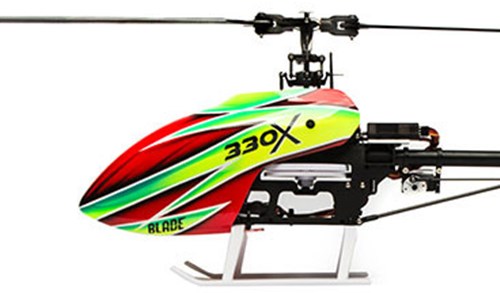 Blade 330X Fiberglass Air Brushed Canopy
Blade 330X Fiberglass Air Brushed CanopyThe next improvement is hard to miss - the canopy!
Blade has opted to use a higher quality fiberglass canopy over the previous 400/450 polycarbonate versions. Top it off with a breathtaking air brushed, high visibility paint scheme, and you get one pretty and very easy to see bird.
Bright and highly contrasting colors like this improve visual acquisition helping prevent disorientation to such a large extent, I have to wonder why it took this long for some manufacturers to get on board with outstandingly bold paint jobs such as this?
It's one of the least costly upgrades to any RC helicopter that likely has the largest overall impact in both a visual sense, and even one of desirability. Heli's that look good after all, are easier to sell.
Yes, I and you should be looking at mechanical & electronic specifications first and foremost as the canopy can always be upgraded (at extra cost), and has little to do with overall flight performance. I would be lying however if I said the out of the box canopy color scheme plays no roll at all in any heli purchase decision I have made.
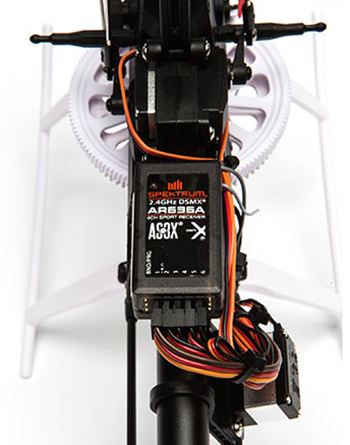 Blade 330X Spektrum AR636A FBL Unit
Blade 330X Spektrum AR636A FBL UnitLast up is the flybarless system (FBL unit).
Unlike the 450X that used the very popular and very decent Spektrum AR7200BX, which is basically a Beast X FBL unit with a built in Spektrum DSM2/X receiver; the Blade 330X uses a somewhat proprietary Spektrum 636A combination FBL and DSMX receiver.
This to some may be a Blade 330X downgrade, and I would certainly fall into that category myself.
The AR7200BX after all was such a good FLB unit that added value to the 450X. It could be used in all types and sizes of collective pitch flybarless RC helicopters equally well when you upgraded to a larger helicopter for example. That said, I do understand the reasoning of using this "lesser" 636A unit.
First off is it's more cost effective at roughly 1/3 the price of the Spektrum AR7210BX, but this is in the short term. I say short term because while the upfront cost of the unit is certainly less, you can't use it in many other heli's later on if you wish like you can with a fully configurable/programmable flybarless unit such as the AR7200BX.
Now, I don't know how many other helicopters the 330X's 636A FBL unit could work well in? I suspect it would only be similar size and weight 450 size helicopters in the exact same mounting orientation (horizontal, face side up, servo leads to the rear).
I could certainly be wrong about that and if so, I would love to get confirmed, fact based feedback if that is the case. You can after all access PID gain adjustments within the 636A though a complicated stick programming method, or through Spektrum's telemetry text generator available on some of their computerized radios.
Systems like this 636A are factory programmed & configured to the helicopter. It's very much exactly like what Align did with their 3GX MR/S FLB unit that was totally specific to their 450 Plus and 250 Plus (a setting was changed in the unit for either size helicopter).
It's this "pre-factory configuration" however that makes units like the Align 3GX MR/S and the Spektrum 636A better suited for newbies first getting into the hobby. I talk about all this in much more detail on my flybarless page, and in my swashplate & FBL configuration eBook, but the more configurable & programmable a flybarless system is, the harder and more complicated it is to setup correctly.
You also need to be able to fly fairly well to correctly set and tune most of them up. If you have never flown a CP heli before, that's a huge show stopper unless you are getting help from an instructor or experienced RC heli pilot so they can dial all that in for you first.
So, while a pre-programmed & configured Spektrum 636A FBL unit may not be what us experienced hobbyists would like to see in a 450 size machine, it makes perfect sense for the CP newbie who is just getting into the hobby and already has a steep learning curve to climb. By taking FBL programming and tuning frustrations out of the equation, that will go a long way to ensure success over frustration sapping failure.
Once again, as you progress, you can always upgrade the FBL unit if you wish to one of the high end, fully configurable types, but I'm sure for most people starting out, this unit will serve you well in the 330X.
As shown in the video below, the performance envelope of the Blade 330X is more than acceptable for most newbies. Even after almost 30 years of flying RC helicopters, I know it will do more than I will ever need.
The Blade 330X Doesn't Have SAFE
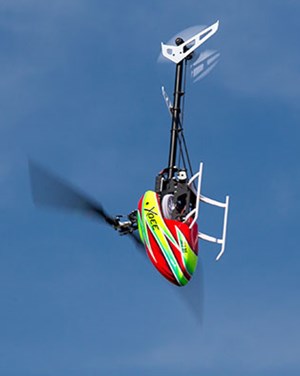 Don't Rely On SAFE With This Bird
Don't Rely On SAFE With This BirdIf you don't know what SAFE is, I explain it in detail on my Blade Helicopter Page.
It's basically added electronic stability help for those that really feel they need it.
Most experienced RC Helicopter and fixed wing pilots dislike it, but at least it can be turned off.
The Blade 330X doesn't have this "artificial electronic help", giving you a real CP learning experience. Like I said, we are going back to the good old basics with this helicopter and to be perfectly honest, I'm thrilled over that decision.
I'm very likely in the minority here, but to me, not having SAFE does two things equally well.
It forces you to quickly & properly learn the
balancing act of hovering a collective pitch helicopter and it allows
you to learn correct setup to tame one down over relying on electronics
to do it for you.
If you want 3 axis accelerometer electronic help, cross the 330X off your list. If you really want to learn how to fly a CP heli out of the gate like we all used to, keep it on.
Two Customary 330X Versions
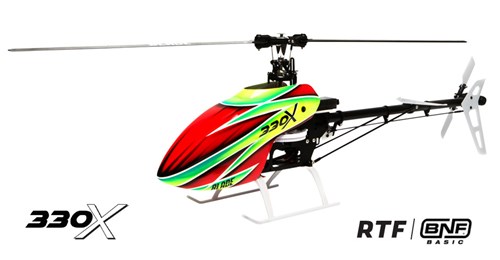 Blade 330X RTF & BNF Versions
Blade 330X RTF & BNF VersionsAs with many of Blade's helicopters, the 330X comes in two familiar versions; Ready To Fly (RTF), and Bind and Fly (BNF).
Like most, I'm a huge fan of BNF and feel this is one of the best things to have graced our hobby over the past decade.
If you don't know what BNF is or why it's such a great feature, again, I explain it in detail on my Blade Helicopter Page.
If you do know what it is, you likely already have a computerized Spektrum Radio so you would naturally be looking at the BNF Basic version of the 330X. The BNF Basic 330X comes with the built up heli and all on board electronics all ready programmed and ready to bind to your 6 channel+ Spektrum, JR, or clone, DSM2/X computerized radio.
The BNF Basic version doesn't come with the radio naturally, flight
battery, or LiPo charger. At around $390 USD, the value is decent.
The
ready to fly version on the other hand is $90 bucks more ($480 USD).
That extra $90 bucks gives you a 6 channel Spektrum DXe radio, one 3S
2200 mAh 30C LiPo battery, and a very inexpensive barley adequate LiPo charger. Basically every thing needed to fly the rascal out of the box.
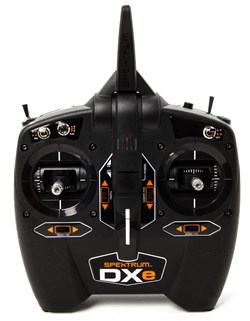 Spektrum DXe 6 Channel Radio
Spektrum DXe 6 Channel RadioThe Spektrum DXe is a 6 channel radio (minimum number of channels to control a collective pitch RC helicopter).
The DXe is also a computerized radio although programming has to be done by external display methods using a smart phone or laptop/PC using Spektrum's free software application.
Thus no LCD display on the radio (to save costs naturally).
Programming an RC radio using
external display devices is a royal PIA! It works, but it's far from practical or particularly easy. Making simple and quick on the fly programming adjustments is all but impossible.
If you are honestly serious about getting into the hobby and the RFT version Blade 330X will be your first helicopter and DXe, your first radio; I strongly recommend getting the BNF version over the RTF version, and put that $90 bucks toward a proper computerized radio with display.
As I say many times, the radio in this hobby is more important than the aircraft and should be your more important decision.
The Spektrum DX6e for example at $150USD would be a much better choice or perhaps the DX6 at $180 USD, if you want a radio with "voice alert".
Yes, along with the added
cost of a LiPo battery and LiPo charger, you will be closing in on $600
or over for the bird, better radio, battery, and charger; but please don't
overlook getting a decent radio. Even if it's a used computerized Spektrum radio, which you can find many good deals on.
The DXe will work, but again, like I often say, the radio is the "heart" of the hobby, don't overlook its importance.
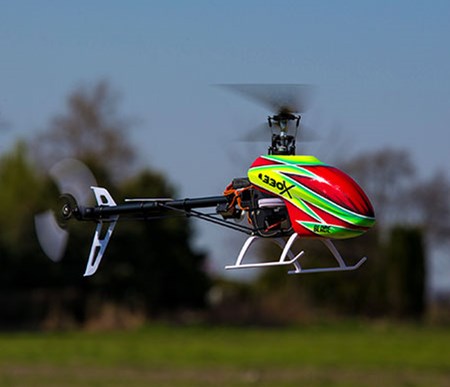
330X Specifications, Owners Manual, & Ordering Information
- Heli Size / Class: 450 Size, Electric Powered, Collective Pitch
- Completion Levels: RTF & BNF
- Length: 25.8" (655mm)
- Height: 8.8" (225mm)
- Main Rotor Diameter: 28.5" (725mm)
- Tail Rotor Diameter: 6.1" (155mm)
- Tail Drive Method: Belt
- Flying Weight: Apx. 27oz (774g)
- Swashplate/Head Type: 120 Degree eCCPM, Flybarless
- FBL/RX System: Spektrum AR636A AS3X DSM2/X Protocol
- Motor: 450 Class Brushless Outrunner, E-flite 440H 4200Kv
- ESC: Blade BLH5052 45 Amp, Governor Capable
- Cyclic Servos: 3X Spektrum H3050 Sub-Micro Digital MG / Torque 29 oz-in (2.1kg-cm) @ 4.8V; 36 oz-in (2.6kg-cm) @ 6V / Speed:0.067 sec/60 deg @ 4.8V; 0.053 sec/60 deg @ 6V, at no load
- Tail Servo: 1X Spektrum H3060 Sub-Micro Digital MG / Torque:12 oz-in (0.9kg-cm) @ 4.8V; 15.75 oz-in (1.1kg-cm) @ 6V / Speed:0.036 sec/60 deg @ 4.8V; 0.029 sec/60 deg @ 6V, at no load
- Flight Battery: LiPo 3S 11.1V 2200mAh 30C+
- Approximate Flight Time: 4-8 min flying style and head speed dependent
As an Amazon Associate I earn from qualifying purchases.
